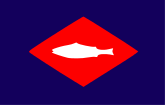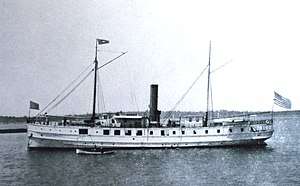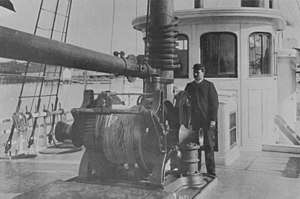United States Fish Commission
|
United States Commission of Fish and Fisheries (1871-1903) United States Bureau of Fisheries (1903-1940) | |
 Flag of the United States Bureau of Fisheries | |
| Agency overview | |
|---|---|
| Formed | 9 February 1871 |
| Preceding agency |
|
| Dissolved | 30 June 1940 |
| Superseding agency | |
| Jurisdiction | United States federal government |
| Parent agency |
none (1871-1903) U.S. Department of Commerce and Labor (1903-1913) U.S. Department of Commerce (1913-1939) U.S. Department of the Interior (1939-1940) |
The United States Fish Commission,[1] formally known as the United States Commission of Fish and Fisheries, was an agency of the United States government created in 1871 to investigate, promote, and preserve the fisheries of the United States. In 1903, it was reorganized as the United States Bureau of Fisheries, which operated until 1940. In 1940, the Commission became part of the newly created United States Fish and Wildlife Service, under the United States Department of the Interior.
History
1871–1940
Robert Barnwell Roosevelt, a Democratic congressmen from New York's 4th Congressional District, originated the bill to create the U.S. Fish Commission in the United States House of Representatives. It was established by a joint resolution (16 Stat. 593) of the United States Congress on February 9, 1871,[2] as an independent commission with a mandate to investigate the causes for the decrease of commercial fish and other aquatic animals in the coastal and inland waters of the United States, to recommend remedies to the U.S. Congress and the states, and to oversee restoration efforts. The Commission was organized into three divisions: the Division of Inquiry respecting Food-Fishes and Fishing Grounds, the Division of Fisheries, and the Division of Fish-Culture.[3]
By an Act of Congress of February 14, 1903, the U.S. Fish Commission became part of the newly created United States Department of Commerce and Labor and was reorganized as the United States Bureau of Fisheries, with both the transfer and the name change effective on July 1, 1903.[4] In 1913, the Department of Commerce and Labor was divided into the United States Department of Commerce and the United States Department of Labor, and the Bureau of Fisheries became part of the new Department of Commerce.[5] In 1939, the Bureau of Fisheries was transferred to the United States Department of the Interior,[6] and on June 30, 1940, it was merged with the Interior Department's Division of Biological Survey to form the new United States Fish and Wildlife Service, an element of the Interior Department.[7]
Later developments
In 1956, the Fish and Wildlife Service divided its operations into two bureaus, the Bureau of Sport Fisheries and Wildlife and the Bureau of Commercial Fisheries, with the latter inheriting the history and heritage of the old U.S. Fish Commission and U.S. Bureau of Fisheries.[8] Upon the formation of the National Oceanic and Atmospheric Administration (NOAA) within the Department of Commerce on October 3, 1970, the Bureau of Commercial Fisheries merged with the saltwater laboratories of the Bureau of Sport Fisheries and Wildlife to form today's National Marine Fisheries Service (NMFS), an element of NOAA,[9] and the former Bureau of Commercial Fisheries' research ships were resubordinated to NOAA's fleet. The NMFS is considered the modern-day successor to the U.S. Fish Commission and U.S. Bureau of Fisheries, and the NOAA fleet of today also traces its history in part to them.
Work

The Commission was led first by Spencer F. Baird,[1] then Marshall McDonald, George Brown Goode, and finally George Bowers.
The U.S. Fish Commission carried out extensive investigations of the fishes, shellfish, marine mammals, and other life in the rivers, lakes, and marine waters of the United States and its territories; corresponded widely with marine researchers around the world; scrutinized fishing technologies; designed, built, and operated hatcheries for a wide variety of finfish and shellfish; and oversaw the fur seal "fishery" in the Territory of Alaska, including the Aleutian Islands. The Commission′s research stations and surveys collected significant data on U.S. fish and fishing grounds, with considerable material going to the Smithsonian Institution.[1] Three ships were built for the Commission: the 157-foot-long (48 m) schooner-rigged steamer USFC Fish Hawk served as a floating fish hatchery and fisheries research ship from 1880 to 1926; the 234-foot-long (71 m) brigantine-rigged steamer USFC Albatross operated as a fisheries research ship from 1882 to 1921 except for brief periods of United States Navy service in 1898 and from 1917 to 1919;[10] and the 90-foot-long (27 m) sailing schooner USFC Grampus was commissioned in 1886 and operated as a fisheries research ship until at least 1921. The Edenton Station hatchery was established in 1899.[11]
From 1871 to 1903, the Commission's Annual Report to Congress detailed its efforts and findings in all of these areas.[12] From 1881 to 1903, the Commission also published an annual Bulletin of the United States Fish Commission summarizing the commission's Annual Report to Congress and correspondence;[13] the bulletins included detailed catch reports from fishermen and commercial fishing port agents around the United States and Canada, reports and letters from naturalists and fish researchers around the United States and in other countries, and descriptions of the Commission's exploratory cruises and fish hatchery efforts. Beginning in 1884, the Commission published the seminal work The Fisheries and Fisheries Industries of the United States.[14]
Gallery




.jpg)
References
- 1 2 3 "Spencer Baird and Ichthyology at the Smithsonian: U.S. FISH COMMISSION". Smithsonian National Museum of Natural History. Smithsonian Institution. Retrieved September 11, 2017.
- ↑ "22.3, General records of the U.S. Fish Commission and the Bureau of Fisheries, 1870-1940", Records of the U.S. Fish and Wildlife Service [USFWS], The U.S. National Archives and Records Administration, retrieved September 11, 2017
- ↑ Stevenson, Charles H. (April 1903). "The United States Fish Commission" (PDF). The North American Review: 593–601. Retrieved September 11, 2017.
- ↑ "Fisheries Historical Timeline: Historical Highlights 1900's". NOAA Fisheries Service: Northeast Fisheries Science Center. National Oceanic and Atmospheric Administration (NOAA). June 16, 2011. Retrieved September 11, 2017.
- ↑ "Fisheries Historical Timeline: Historical Highlights 1910's". NOAA Fisheries Service: Northeast Fisheries Science Center. National Oceanic and Atmospheric Administration (NOAA). June 16, 2011. Retrieved September 11, 2017.
- ↑ "Fisheries Historical Timeline: Historical Highlights 1930's". NOAA Fisheries Service: Northeast Fisheries Science Center. National Oceanic and Atmospheric Administration (NOAA). June 16, 2011. Retrieved September 11, 2017.
- ↑ "Fisheries Historical Timeline: Historical Highlights 1940's". NOAA Fisheries Service: Northeast Fisheries Science Center. National Oceanic and Atmospheric Administration (NOAA). June 16, 2011. Retrieved September 11, 2017.
- ↑ "Fisheries Historical Timeline: Historical Highlights 1950's". NOAA Fisheries Service: Northeast Fisheries Science Center. National Oceanic and Atmospheric Administration (NOAA). June 16, 2011. Retrieved September 11, 2017.
- ↑ "Fisheries Historical Timeline: Historical Highlights 1970's". NOAA Fisheries Service: Northeast Fisheries Science Center. National Oceanic and Atmospheric Administration (NOAA). June 16, 2011. Retrieved September 11, 2017.
- ↑ "Pacific Expeditions of the US Fish Commission Steamer Albatross, 1891, 1899–1900, 1904–1905". Harvard University Library Open Collections Program: EXPEDITIONS & DISCOVERIES. Harvard University. Retrieved September 11, 2017.
- ↑ Butchko, Thomas R. (April 2002). "Edenton Station, United States Fish and Fisheries Commission" (PDF). National Register of Historic Places - Nomination and Inventory. North Carolina State Historic Preservation Office. Retrieved August 1, 2014.
- ↑ "United States Commission of Fish and Fisheries: Annual Reports 1871-1903". 19th & Early 20th Century Marine Ecology & Fisheries Research Reports. Friends of Penobscot Bay. Retrieved September 11, 2017.
- ↑ "The Bulletin of the United States Fish Commission. Selected reports 1881-1901". 19th & Early 20th Century Marine Ecology & Fisheries Research Reports. Friends of Penobscot Bay. 2006. Retrieved September 11, 2017.
- ↑ United States Commission of Fish and Fisheries (1887), The Fisheries and Fisheries Industries of the United States (PDF), Washington, DC: Government Printing Office, retrieved September 11, 2017
| Wikisource has the text of The New Student's Reference Work article about United States Fish Commission. |